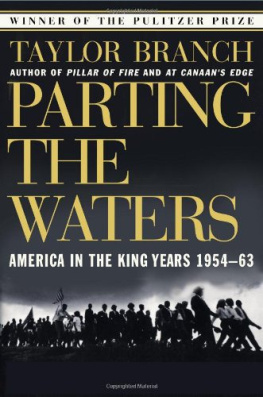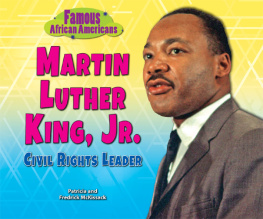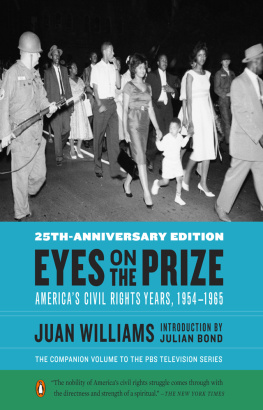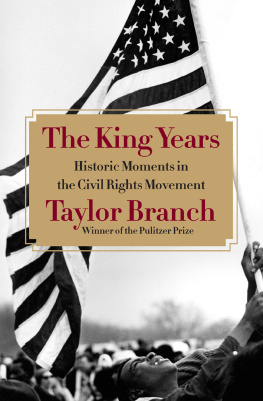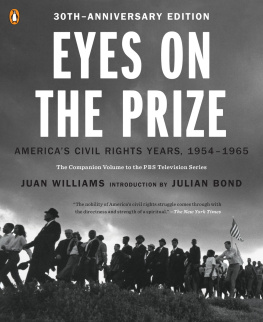
Acclaim for the Pulitzer Prize winner Parting the Waters
In remarkable, meticulous detail, Branch provides us with the most complex and unsentimental version of King and his times yet produced.
Robert C. Maynard,
The Washington Post Book World
Endlessly instructive and fascinating, thorough, stupendous. Now the source and standard in its field.
David Levering Lewis,
The Philadelphia Inquirer
A compelling story, masterfully told.
Richard John Neuhaus,
The Wall Street Journal
A masterpieceremarkably revealing. The past, miraculously, seems to spring back to life.
Jim Miller,
Newsweek
Already, in this chronicle, there is the material of Iliad after Iliad . There is no time in our history of which we can be more proud.
Garry Wills,
The New York Review of Books
Superb history.
Robert Wilson,
USA Today
A wide-ranging, monumental tapestry. Branch recounts the turbulent era with feeling and insight.
David Anderson,
United Press International
A brilliantly written saga that breathes life into the people and passions of the King years.
Harold C. Fleming,
The News and Observer Book World
A book that excites as the best history ought toa notable achievement.
Roger Harris,
Newark Star-Ledger
A dense, elegant narrative that ranges from the back of the bus in Montgomery, Alabama, to the Oval Office. Branch has reconstructed an era that changed America forever.
Kim Hubbard and Linda Kramer,
People
Branch gives us a canvas as broad, varied and richly peopled as a medieval religious painting. Should be required reading for every black and white citizen of the state.
Garland Reeves,
The Birmingham News
A thrilling portrait.
Ruth Gilbert,
New York magazine
Branch has fit together all the piecesthe people, places, eventsto show relationships, the larger picture we may have missed or forgotten. With this ordered, sweeping look at the movement and King, we are able to put things into perspective.
Patsy Sims,
Chicago Sun-Times
Importanta marvelous book about a man and a movement.
Leslie W. Dunbar, The Atlanta Journal and Constitution
Simply superior in every aspect.
Ray Jenkins,
The Baltimore Sun
Also by Taylor Branch
Pillar of Fire
Blowing the Whistle: Dissent in the Public Interest (with Charles Peters)
Second Wind (with Bill Russell)
The Empire Blues
Labyrinth (with Eugene M. Propper)

Simon & Schuster
Rockefeller Center
1230 Avenue of the Americas
New York, NY 10020
Copyright 1998 by Taylor Branch
All rights reserved,
including the right of reproduction
in whole or in part in any form.
S IMON & S CHUSTER and colophon are
registered trademarks of Simon & Schuster, Inc.
The Library of Congress has cataloged the hardcover edition as follows:
Branch, Taylor.
Parting the waters: America in the King years, 1954-63/Taylor Branch.
p. cm.
Bibliography.
1. Afro-AmericansCivil rights. 2. Civil rights movements
United StatesHistory20th century. 3. King, Martin Luther, Jr.,
1929-1968. 4. United StatesHistory1961-1969. I. Title.
E185.61.B7915 1998
88-24033
CIP
9730496073dc19
ISBN-13: 978-1-4165-5868-2
ISBN-10: 1-4165-5868-3
We are grateful for permission to quote from "Listen, LordA Prayer in Gods Trombones by James Weldon Johnson. Copyright 1927 by The Viking Press, Inc. Copyright renewed 1955 by Grace Nail Johnson.
Visit us on the World Wide Web:
http://www.SimonSays.com
For the Choir of
All Souls Unitarian Church, Washington, D.C.
And in memory of
Septima Poinsette Clark
CONTENTS
PREFACE
1. FORERUNNER: VERNON JOHNS
2. ROCKEFELLER AND EBENEZER
3. NIEBUHR AND THE POOL TABLES
4. FIRST TROMBONE
5. THE MONTGOMERY BUS BOYCOTT
6. A TASTE OF THE WORLD
7. THE QUICKENING
8. SHADES OF POLITICS
9. A PAWN OF HISTORY
10. THE KENNEDY TRANSITION
11. BAPTISM ON WHEELS
12. THE SUMMER OF FREEDOM RIDES
13. MOSES IN McCOMB, KING IN KANSAS CITY
14. ALMOST CHRISTMAS IN ALBANY
15. HOOVERS TRIANGLE AND KINGS MACHINE
16. THE FIREMANS LAST REPRIEVE
17. THE FALL OF OLE MISS
18. TO BIRMINGHAM
19. GREENWOOD AND BIRMINGHAM JAIL
20. THE CHILDRENS MIRACLE
21. FIRESTORM
22. THE MARCH ON WASHINGTON
23. CROSSING OVER: NIGHTMARES AND DREAMS
ACKNOWLEDGMENTS
ABBREVIATIONS USED IN SOURCE NOTES
NOTES
MAJOR WORKS CITED IN NOTES
INDEX
PREFACE
Almost as color defines vision itself, race shapes the cultural eyewhat we do and do not notice, the reach of empathy and the alignment of response. This subliminal force recommends care in choosing a point of view for a history grounded in race. Strictly speaking, this book is not a biography of Martin Luther King, Jr., though he is at its heart. To recreate the perceptions within his inherited world would isolate most readers, including myself, far outside familiar boundaries. But to focus upon the historical King, as generally established by his impact on white society, would exclude much of the texture of his life, which I believe makes for unstable history and collapsible myth.
To overcome these pitfalls of race, I have tried to make biography and history reinforce each other by knitting together a number of personal stories along the main seam of an American epoch. Like King himself, this book attempts to rise from an isolated culture into a larger history by speaking more than one language.
The text moves from King to people far removed, at the highest and lowest stations. By seeking at least a degree of intimacy with all of themold Mother Pollard and also President Eisenhower, Bob Moses of SNCC and also J. Edgar Hoover of the FBI, with the Kennedys and also Kings rivals within the black churchI hope to let the characters define each other.
My purpose is to write a history of the civil rights movement out of the conviction from which it was made, namely that truth requires a maximum effort to see through the eyes of strangers, foreigners, and enemies. I hope to sustain my thesis that Kings life is the best and most important metaphor for American history in the watershed postwar years.
The chosen structurenarrative biographical historyhas influenced several elements of style. For example, the word Negro is employed here in narrative covering the years when that term prevailed in common usage. Far from intending a political statement, I merely hope to recreate the feeling of the times, the better to capture the sweep of many changes including the extraordinary one in which the entire society shifted from Negro to black almost overnight. Because of the length of this work, for which I beg the readers indulgence, that shift falls within the span of a second volume.
On another matter of housekeeping, I regret having to leave the record on Stanley Levison slightly ajar. Since 1984, I have sought the original FBI documents pertaining to the Bureaus steadfast contention that Kings closest white friend was a top-level Communist agent. On this charge rested the FBIs King wiretaps and many collateral harassments against the civil rights movement. In opposing my request, the U.S. Department of Justice has argued in federal court that the release of thirty- to thirty-five-year-old informant reports on Levison would damage the national security even now. Almost certainly there is bureaucratic defensiveness at work hereand also, I suspect, some petty spy rivalry with the CIAbut so far the logic of secrecy has been allowed to reach levels of royalist absurdity.

